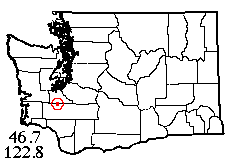
Spider Collector's Journal (13th page: 2002-03) Copyright © 2005 by Rod Crawford
As explained on the first page, most of these notes of fun (and not so fun) trips to collect spiders for research at the Burke Museum appeared in Scarabogram, newsletter of "Scarabs: The Bug Society," in their original forms. References to the editor mean me; most other persons mentioned are Scarabs members. Dates of field trips head each paragraph. Maps showing the location of sites within Washington state follow the grid system outlined in the Washington Spider Checklist. RETURN TO INDEX
 |
25 IV 2002: On April 25, Jerry Austin, yr editor, and artist Louise Smith headed for the Tenino area. Louise wanted some Garry Oak buds to paint; alas, they weren't budding yet. Jerry wanted to pursue his new interest in fungus gnats, and of course I wanted spiders as usual. We hiked up a railroad track near Bucoda to a series of meadows on the east side of the Skookumchuck River. Unfortunately, invasive Eurasian blackberry species are taking over habitats here, as elsewhere in western Washington, but the open meadow was still largely blackberry-free, and yielded 13 foliage spider species to the sweep net and 3 wolf spider species to the chase. Nearby habitats of Symphoricarpos shrubs, log bark, ground moss and cedar branches brought the total up to 37 spider species. The Douglas-fir branches, usually a rich habitat, this time yielded only abundant foraging ants (who were not at all pleased at being disturbed!). The most interesting spider species was Xysticus cristatus, a new European crab spider import first found in Discovery Park (Seattle) in the mid-90s; found in Pierce and Thurston counties this year.
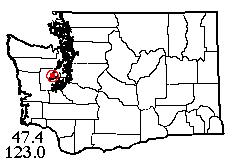 |
24 V 2002: On May 24, Louise decided she was ready for another try at oak buds. This time we went to Oak Patch Lake in Mason County, and succeeded. A few hours at nearby Lone Duck Pond, which apparently has a floating Sphagnum island (inaccessible) in the middle, yielded 21 spider species from such habitats as leaf litter, moss on trees, conifer foliage, and under stones. Louise was impressed by the unique "heath shrub prairie" vegetation found only in this area. The greatest find of the trip, however, was a little diner in the eastern outskirts of Belfair called "Hot Dogs R Me" (yes, I'm not kidding). They have a variety of gourmet "dogs" which just precisely hit the spot!
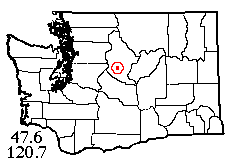 |
31 V 2002: In late May and June, visiting Finnish lepidopterist Markku Savela (who attended the May Scarabs meeting) went on a number of local photography trips, two accompanied by yr editor. Markku displays the results of his worldwide photography of plants, butterflies and some other groups on his web site which is well worth a visit. On May 31, Markku, Jerry Austin, and yr editor went over Stevens Pass to the well-known Tumwater Canyon (of the Wenatchee River) and up Hatchery Creek Road, one of the few side roads in the area. We settled down for our field day at a mid elevation site (2300-2400 feet) with thin Douglas-fir/Ponderosa pine forest, clearings with Ceanothus shrubs, and some small streams with alder and vinemaple. It was a fine day but Markku had bad luck; the butterflies were flying too fast to photograph, the light was too strong to photograph plants, and the temperature a bit too high for someone fresh from Finland; the poor fellow ended with a mild case of heat stroke. On the plus side, we got 38-39 spider species including the extremely speedy Poecilochroa columbiana and the beautiful jumping spider Habronattus jucundus.
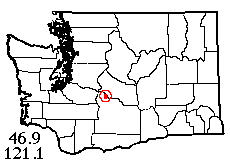 |
6 VI 2002: On June 6, Markku and I went over the newly opened Chinook Pass (driving between snow banks higher than the car for miles) and down the American River to where it is joined by the Bumping River. Hiking up a gated side road, we came to a spectacularly beautiful, essentially pristine mountain meadow at just over 3000 feet. A plaque by the log building just outside the meadow identified it as the "American Ski Bowl Lodge," constructed in the early 1930s by the CCC (new-deal program, Civilian Conservation Corps), still in good shape and available for use by reservation with the Forest Service. The habitats also include a sedge marsh and several varieties of forest, open Ponderosa pine, fire-seral lodgepole pine and denser Douglas fir-true fir. The mostly cloudy and cool weather was not conducive to butterflies, but perfect for plant photography, and Markku shot three rolls, some of which should appear on his web site in due course. Spiders were found active in the meadow, under stones, in logs, in wet moss, in foliage of the conifers, the forest understory, and the meadow, and several interesting species in the historic cabin, which is in fine shape and (no doubt due to the road being gated) unvandalized. Total, 32 species; the more interesting included an uncommon wolf spider Tarentula aculeata, a crab spider Philodromus speciosus new to the state, and one of our smallest spiders, Symmigma minimum. The more Finland-style weather was most pleasant, too.
 |
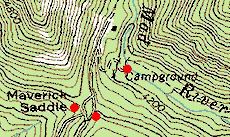 |
2 VII 2002: Yr editor's friend Della had a rental car and wanted to go on a "picnic," fully understanding that with me along it would be a picnic second and a spider collecting trip first! Jerry Austin also came along to assist. Due to the lateness of the season, the elevation had to be relatively high, and there aren't many high places in day-trip range accessible by a town car, but I thought I'd found one: a pass called Maverick Saddle on Entiat Ridge in Chelan County, with a short trail down the far side to the Mad River, and all of it over 4000' elevation. Everything went smoothly up to the base of the ridge. Then the last 2 or 3 miles of road, taking us to the saddle, proved to be strewn with rocks just a little too big for our low-slung car to pass over comfortably! For Della's peace of mind (and deposit), Jerry and I took turns walking ahead and picking up rocks. And there weren't even any spiders under them. However, the saddle, when reached, was a pretty spot with a fairly open forest of pine, Douglas and true firs with herbaceous-shrubby clearings. The trail down to the river gave access to a rocky streamside, riparian clearings and woodland with alder, vine maple, Ceanothus and manzanita, and a somewhat different forest - plus a little campground with a picnic table to sift on. Foliage (various kinds), litter, visual searching, and the outhouse gave us about 29 species including a nice variety of Theridion and a Disembolus that might be new. On the way down, I again walked ahead and threw rocks while Della worried. We rewarded her with a restaurant dinner whilst passing through Monroe.
8 VII 2002: Right after the above trip, I was asked to train Cuyler Boad, the student who was to collect spiders on the 2002 Sakhalin expedition (there was no money to send me, and I'd gone in 2001 anyway). We had the same problem of the lowlands being too late for spiders, and Cuyler had a high-wheeled 4-wheel drive truck, so I thought here's my chance to explore Entiat Ridge for other good spots. Unfortunately, we went through mile after mile of high country destroyed by a recent forest fire, and ended up at the same Maverick Saddle site as the best place to demonstrate techniques and actually get some spiders. Our time wasn't wasted, though: we found much better leaf litter than the week before, and that, with rotten wood collecting, boosted the species total up to 40, a couple of which looked unfamiliar. Finally, near dusk we stopped by the Fish Lake Sphagnum bog so I could show Cuyler what the best of all spider habitats looks like.
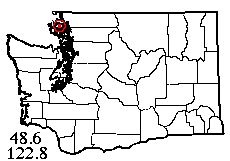 |
14-17 X 2002: Moran State Park. I had been contacted by someone at the Moran Outdoor School at the large state park on Orcas Island, asking how to tell if there were hobo spiders (Tegenaria agrestis) on the grounds, as fearful visitors suspected. Craftily, I suggested that the best way to find out would be to do a spider survey of the park. They arranged collecting permission, and on Monday the 14th I rode up to Orcas Island with some AmeriCorps volunteers and was greeted by Marta Branch, park ranger and head of the outdoor school. She installed me in sumptuous guest quarters called the "Vacation Home," complete with cable TV! That night, there was just time to collect a few spiders around the HQ cabins.
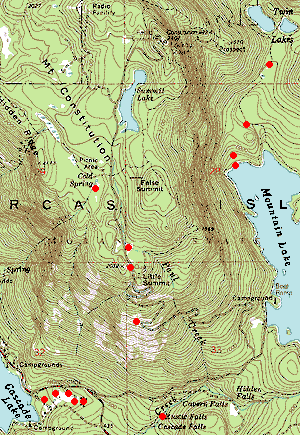 |
| Collecting sites in Moran State Park |
In the morning, I went with Marta and some volunteers to a series of bogs on
Mt. Constitution that I'd read about in Rigg's "Peat Resources of Washington."
One turned out to be on private land, one had little living Sphagnum,
but the one at Cold Spring was in excellent shape and produced plenty of spiders.
Included were such bog endemics as Callioplus wabritaskus and Hybauchenidium
cymbadentatum, and an unnamed crab spider which I previously collected at
Carlisle Bog on the coast. After searching
some time in vain for a cave someone thought existed near a trail down the west
side of the mountain, we returned to the lodge area and I collected moss and
understory spiders in a gully leading into Cascade Lake below.
On my second morning
in the park, Marta dropped me off in the steep grassy meadows that make the
south face of Mt. Constitution a unique habitat. There wasn't much to be swept
from the grass, but the pitfalls I set were productive and there were good spiders
on the pines and Douglas-firs at the edges. I climbed to the "little summit"
and found some different species under stones near a quarry, then swept sedge
in a nearby marsh until picked up at lunch time. I had noticed a surprising
lack of leaf litter in the forests at every place I'd so far seen, and Marta
suggested it was due to browsing by a local deer overpopulation. For the afternoon,
she took me to Rustic Falls on Cascade Creek, a delightful, secluded sylvan
spot where I did find a little leaf litter in the waterfall gorge where deer
don't go. Moss and understory foliage were productive also; at dusk, I hiked
on down the trail back to my Vacation Home. Each evening of my visit was spent
inspecting buildings and cabins in the lodge area for house spiders, best found
by flashlight in the dark.
On my last day,
I took a hiking trail up Mountain Lake on the east side of the park and collected
from a narrow lakeshore meadow near the north end, then in a nearby wooded floodplain
area with plenty of stones to search under. Heading on up the trail toward Twin
Lakes, I swept in a small wetland where the sedge, so deeply shaded it was still
wet with dew, produced over 50 Bathyphantes brevipes (obviously in its
ideal habitat) and other species in ones and twos. I still hadn't collected
from rotten wood habitat, so did that in a deep forest site on the way back
to the lake.
From all Moran State
Park sites combined (all within the same 1/10 degree area), I took 82 species
(in 683 specimens), which is not bad but I could have done much better at that
season in a completely unaltered habitat. Over 13% of the species collected
were introduced non-natives, some (like the orbweaver Metellina segmentata)
being so abundant as to largely eliminate their native relatives. The one new
state record of the trip was the introduced Steatoda bipunctata. Fifteen
species were taken around the cabins, including my first adults of our native
Segestria species, but hobo spiders were clearly absent. Thanks to Moran
State Park and Outdoor School and especially to Marta for an enjoyable experience
and a good collection.
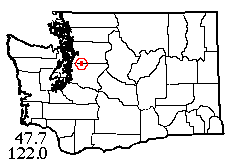 |
25 V 2003: For reasons I can't quite fathom, 2003 was a real slump in spider collecting, and my only trip was a training trip with Steve Kazakian, a student who was to collect spiders on the last (2003) Sakhalin expedition. We went to Paradise Lake in north central King County, a Sphagnum bog I'd visited briefly but postponed spider collecting to a better opportunity. This was it! Paradise Lake bog is on private land but the owners have kept it in essentially pristine condition. Should they ever relinquish it, it should be a prime candidate for nature preserve acquisition. It's a really lovely spot, with extensive Sphagnum, Ledum and even some Pinus contorta within a normal western Washington mixed forest. Steve and I got 24 species in about 2.5 hours, including such bog endemics as Theonoe stridula and Callioplus wabritaskus. Our specimen total for the site was 412. I just totaled Steve's complete spider collection from the expedition, 2295 spiders in 39 days or 59 per day. Maybe a little more training was needed, but localities pre-selected without regard for spider potential probably played a part also. On the 2001 expedition, I totaled 4752 in 37 days or 128/day, only had one 300 specimen day (the day I stayed behind from a group excursion) and no 400 specimen days; so for a beginner, given the unfavorable conditions, Steve didn't do so badly.
This page last updated 21 March, 2025